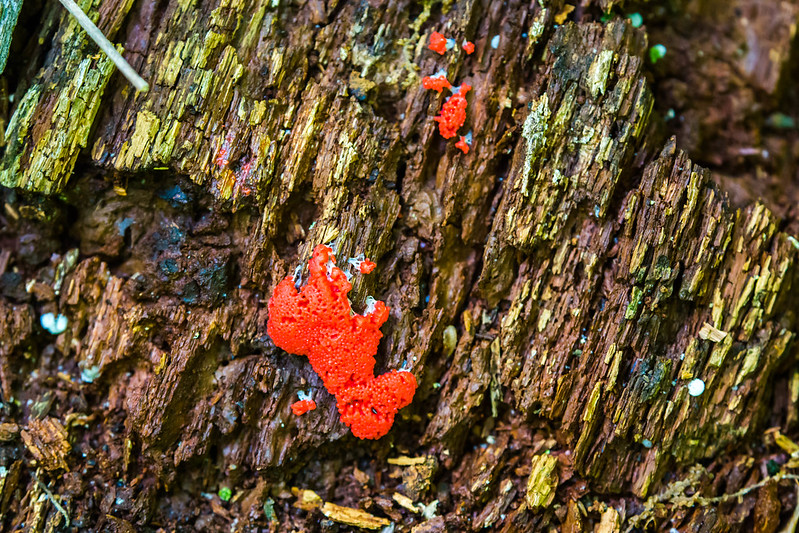What is red mold, you ask? It is a fungus that can grow both outdoors and indoors.
In most cases, you will see them in areas where there is constant moisture and warm conditions.

They can also grow on fabric, drywall, and food. If you are wondering where you might find this inside your home, look in the areas where there is water, typically in places with leaking and plumbing problems.
Most molds change their color throughout their existence, and they may become red for only a specific amount of time. However, red mold is primarily associated with Aspergillus when it grows in building materials, Neurospora in foods, and Fusarium in soil and plants.
What Exactly Is Red Mold?
It is essential to remember that red mold is not a specific type but only an interpretation of its appearance.
Any mold can develop a tinge of red at some point, as changing colors is one of the characteristics of molds. Black mold, green mold, and other types of molds may appear red as well.
Some also associate this with pink mold, but that is a whole different case. If that is the problem you have, here is an article on how to get rid of pink mold.
What Causes Red Mold?
Several factors affect the color of a mold, changing to red. It includes a change in the humidity level of the room it grows in or how exposed the mold is to sunlight.
The food source can also be a factor in these changes. The location of the growth significantly influences how severe the mold is going to be and what appearance it will have.
Like most molds, red mold develops in bathrooms, kitchens, and other areas where moisture is always present. They can also spread to other places through airborne particles, so you should find out how to remove mold spores in the air.
Usually, it takes around 48 hours for mold to start growing. If you do not remove it right from the roots immediately, it can lead to other problems and even potentially become a health risk.
Is Red Mold Dangerous?
Molds are generally harmless to most people, given that their health is in excellent condition. However, it can be a severe problem for mold sensitivity, allergies, and other respiratory distress individuals.
It can also trigger infections to the eyes, skin, lungs, and other organs in some cases. The most vulnerable people from mold are the following:
- Babies
- Toddlers
- Elders
- People with:
- Weak immune systems
- Asthma
- Pneumonia
- Bronchitis
- AIDS
- Lupus
- Cancer
Signs Of Mold Sensitivity
Not everyone has mold sensitivity, but if you believe that you are, here are the symptoms you might be experiencing related to it:
- Constant sneezing
- Nasal congestion
- Skin irritation
- Watery eyes
- Runny nose
- Chest tightness
- Asthma
- Fatigue
- Dizziness
- Headache
- Difficulty in breathing
There is also danger in accidentally ingesting mold, so check your stock food before eating. If you see some red spots on any food you have at home, it would be best to throw it away as it can also affect nearby products.
How To Remove Red Mold
Getting rid of red mold doesn’t require much effort. As long as you know where the roots are, you will be able to remove them altogether.
To start the cleaning process, these are the steps you should follow:
Step #1. Wear protective equipment
It is necessary to wear a mask, goggles, and gloves when dealing with mold as close contact may trigger infections and allergies. They also get rid of mold spores from entering your respiratory tract and causing more internal problems.
It would also be great to open a door or a window before cleaning to encourage proper ventilation in the area.
Step #2. Prepare the cleaning agents
There are available mold cleaners in supermarkets that you can use to remove mold from your walls, but you can also find some alternatives at home. If you choose the latter, prepare the following ingredients:
- Baking soda
- Vinegar
- Hydrogen peroxide
- Bleach
To use, mix one part of each separate ingredient into two parts of water. Do not mix them all, as each mixture alone works excellent in killing molds.
Step #3. Clean the infected surface
After preparing the mixture or product of your choice, soak the moldy surface by spraying it and sitting for an hour. Use a stiff brush and scrub the area abrasively to remove stubborn spots.
Repeat the step, if necessary, until there are no small spots and patches left. Be sure to check the cracks and hard-to-reach areas as well.
Step #4. Encourage proper air circulation indoors
To avoid dealing with mold again in the future, you should always keep the bathroom, kitchen, and laundry area dry.
It might sound ridiculous at first, as these places usually have water and moisture in the atmosphere. By opening a window every day or installing a fan, the air will circulate well, keeping the room dry and receiving natural light regularly.
These precautions are enough to keep mold growths at bay.
Conclusion
Now that you are aware of what is red mold, you know the potential health risks it has for your family. Be sure to follow the steps provided above to help you clean this mold if it happens to grow in your home.
